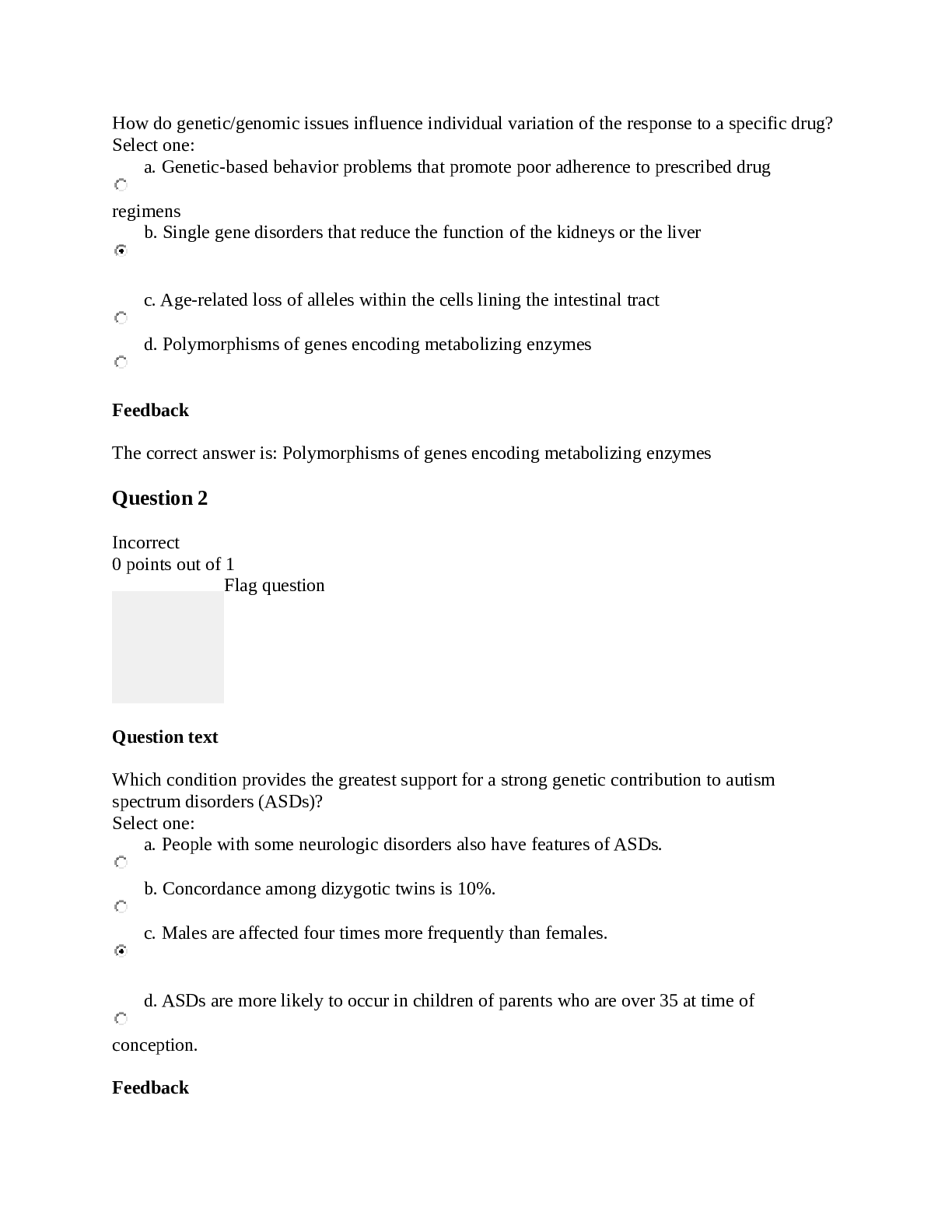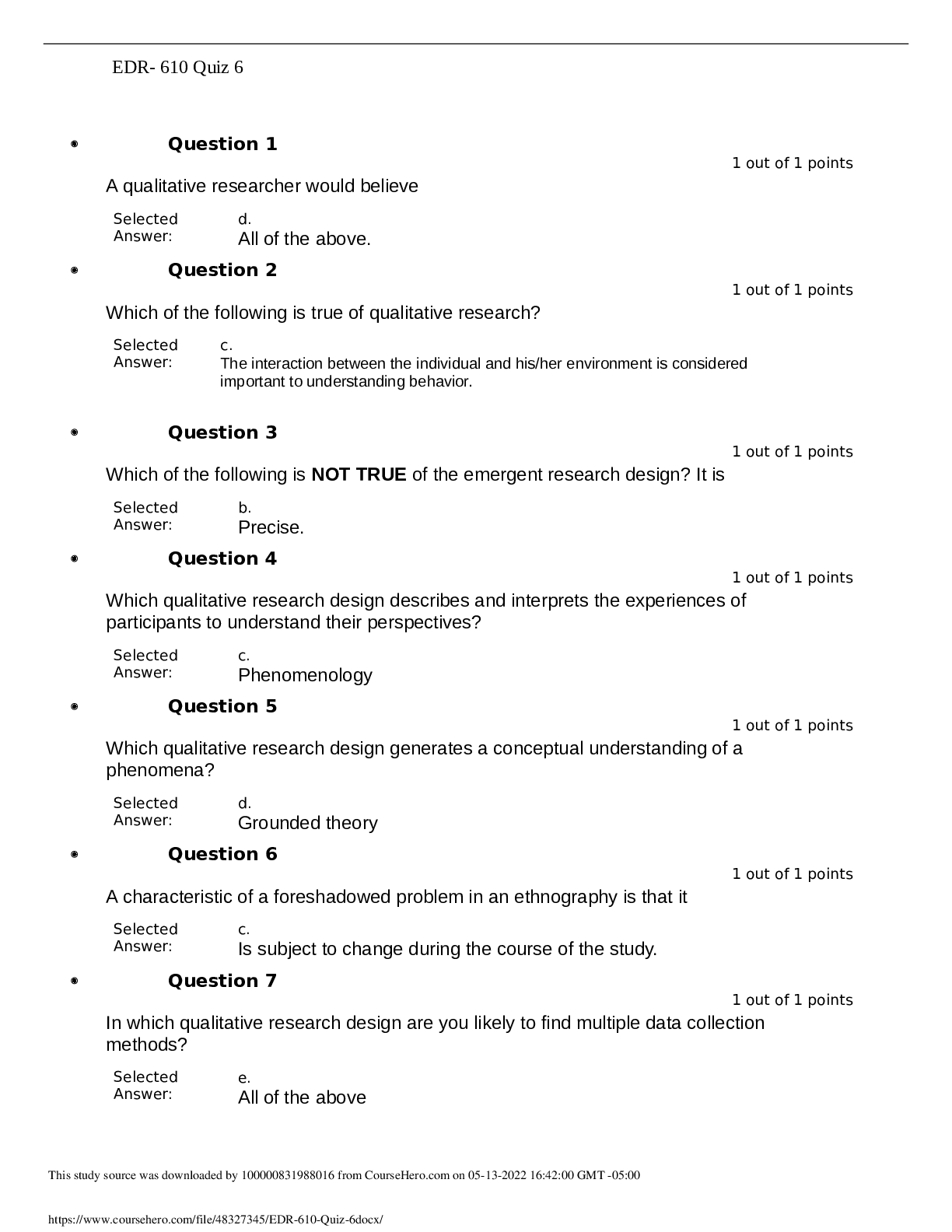NURSING. > EXAM > Rasmussen College: NUR 2063 Patho Test 1 Questions with Answers,100% CORRECT (All)
Rasmussen College: NUR 2063 Patho Test 1 Questions with Answers,100% CORRECT
Document Content and Description Below
Rasmussen College: NUR 2063 Patho Test 1 Questions with Answers 52 Multiple choice questions 1. Pain, Pallor, paralysis, paresthesias, pulselessness. Injury caused when tissues such as b... lood vessels and nerves are constricted within a space as from swelling or from a tight dressing or cast. Swelling in a confined space that produces dangerous pressure; may cut off blood flow or damage sensitive tissue. A. Complications of compartment syndrome B. The 5 P's of compartment syndrome C. Best way to prevent the spread of infection. D. What are B lymphocytes (B cells)? 2. Non-inflammatory, Cartilage destruction, Progressive, Usually occurs due to old age. Also known as wear and tear arthritis and degenerative joint disease, it is a localized joint disease characterized by the deterioration of articulating cartilage an its underlying bone as well as Bony overgrowth. (p 403) A. What is Fibromyalgia? B. What is osteoarthritis? C. What are macrophages? D. What is psoriatic arthritis? 3. Through Osmosis -C6 Assisted by Chloride, which attaches to sodium or water. Bound to sodium it behaves like sodium in regard to water balance. When chloride is bound to hydrogen, it plays an important role in acid-base balance. Kidneys are primarily responsible for chloride excretion, as well as sweating. A. How do we lose fluid from extracellular compartment? B. The best prevention for Pressure ulcers/injuries is to perform what intervention? C. How is fluid between interstitial and intracellular compartments distributed? D. What is rheumatoid arthritis? 4. Usually encapsulated in are unable to metastasize. Similar to normal cells, differentiated, mitosis fairly normal and relatively slow, expanding mass, frequently encapsulated - C1 A. Identity examples of benign cells (Select All) B. The four components of Pathophysiology (Select all) C. Bones cancers and their properties. Osteochondroma D. Identify examples of types of malignant cells (Select All) 5. Undifferentiated (more anaplastic), nonfunctioning cells that are reproducing rapidly. Malignant tumors often penetrate surrounding tissue and spread to secondary sites. Carcinomas on skin, and tissue that cover organs. Stomach, prostate, pancreas, lung, liver, colon, or breast. A. Identity examples of benign cells (Select All) B. Identify examples of types of malignant cells (Select All) C. What is potential and fatal complication of hypernatremia? D. The four components of Pathophysiology (Select all) 6. Primary: do not have the disease and you are trying to prevent it (i.e. Vaccines) Secondary: disease detection (i.e. PAP smears and yearly physicals) Tertiary: trying to prevent problems from the disease or problem (i.e. Rehabilitation) - C1 PP Slide7 A. Prevention and treatment of disease- eg. Primary, Secondary, Tertiary B. Rheumatoid arthritis clinical manifestation? (Select all) C. The best prevention for Pressure ulcers/injuries is to perform what intervention? D. Identity examples of benign cells (Select All) 7. The generalized stimulation of sympathetic nervous system resulting in the release of catecholamine's and cortisol, AKA fight or flight response -C2 A. What happens during the alarm phase of Hans Selye's General Adaptation Syndrome? B. What compounds does the body release during stress? C. The energy currency of a cell and role the mitochondrion plays in this currency D. What are the properties of cancer cells? (Select All) 8. First line of innate attack. Engulf as many as 100 bacteria. White blood cells within tissues, produced by differentiation of monocytes, phagocytize and stimulate lymphocytes and other immune cells to respond to pathogens - C1 A. What is active immunity? B. What are B lymphocytes (B cells)? C. What is Fibromyalgia? D. What are macrophages? 9. Produced in the bone marrow and mature in the thymus—hence "T" cell; include two major types that work to destroy antigens— regulator cells and effector cells. A. What are macrophages? B. The four components of Pathophysiology (Select all) C. What are T lymphocytes (T cells)? D. What are the properties of cancer cells? (Select All) 10. The release of catecholamine sans cortisol -C2 A. What is one mediator of inflammation? B. What compounds does the body release during stress? C. What are the properties of cancer cells? (Select All) D. Where are leukocytes and red blood cells formed? 11. Aldosterone & ADH (Anti Diuretic Hormone) A. What hormones assist with potassium distribution (2 main hormones) B. What happens during the alarm phase of Hans Selye's General Adaptation Syndrome? C. What is potential and fatal complication of hypernatremia? D. Extracellular fluid has higher concentration of which electrolytes/substances (2) 12. Cancer cells leaving a tumor and invading other parts of the body. Spreading of cancer cells. A. What causes gout? B. What is metastasis? C. What is psoriatic arthritis? D. What is one mediator of inflammation? 13. A chronic inflammatory skin condition triggered by an allergen (p 423) A. What is atopic dermatitis? B. What is psoriatic arthritis? C. What is metastasis? D. What is Fibromyalgia? 14. Histamine, serotonin, leukotriene's, prostaglandins - C2 A. What is one mediator of inflammation? B. A lab test that can measure inflammation C. Type 1 hypersensitivity mediator D. Where are leukocytes and red blood cells formed? 15. A generalized wasting syndrome where the person appears emaciated often occurs due to malnutrition. Muscle wasting. C-1 A. What is active immunity? B. What is cachexia? C. What causes gout? D. What is metastasis? 16. • Minimize the force and friction applied to the skin • perform a systematic skin inspection at least once a day • massage vigorously over Bony prominences twice daily • cleanse the skin at the time of soiling and at routine intervals • use pillows to keep the knees other Bony prominences from direct contact with one another A. The best prevention for Pressure ulcers/injuries is to perform what intervention? B. Prevention and treatment of disease- eg. Primary, Secondary, Tertiary C. What is potential and fatal complication of hypernatremia? D. The energy currency of a cell and role the mitochondrion plays in this currency 17. Significant fluid increases in the transcellular compartment are often referred to as third spacing because fluid is not easily exchanged among the other extracellular fluids. Management of fluid excess focuses on identifying and treating the underlying cause. Strategies may consist of wearing compression stockings, administering diuretics, restricting sodium and fluids, and maintaining the patient in high Fowler’s position. A. How do we lose fluid from extracellular compartment? B. Rheumatoid arthritis clinical manifestation? (Select all) C. What are the properties of cancer cells? (Select All) D. What is potential and fatal complication of hypernatremia? 18. Increased capillary permeability. Occurs when hydrostatic an osmotic forces favor the movement of fluid from the intra vascular compartment to the interstitial space. Edema occurs when hydrostatic forces are greater than osmotic forces -C6 A. Cause of edema B. Chondrosarcoma C. Osteosarcoma D. What is Fibromyalgia? 19. Immunity gained by actively engaging with the antigen - that is through invasion or vaccination. The person makes his or her own antibodies, and protection is usually long term. A. What is osteoarthritis? B. What is Fibromyalgia? C. What is cachexia? D. What is active immunity? 20. Fatigue, anorexia, low grade fever, Lymphadenopathy, Malaise, muscle spasms, morning stiffness lasting longer than one hour, warmth, tenderness, and stiffness in the joints when not used for as little as one hour, bilateral joint pain, swollen and boggy joints, limited joint range of motion, contractures and joint deformity. I E boutonniere deformity and Swan neck deformity. Unsteady gait, depression, anemia. (p 405) A. What activity is appropriate for osteoarthritis? B. Identify examples of types of malignant cells (Select All) C. Rheumatoid arthritis clinical manifestation? (Select all) D. What is potential and fatal complication of hypernatremia? 21. Chronic pain and stiffness involving entire body, minor exertion aggravates pain and fatigue. A syndrome predominantly characterized by widespread muscular pains and fatigue. This disorder affects joints, muscles, tendons, and surrounding tissues. (p 410) A. What is atopic dermatitis? B. What is Fibromyalgia? C. What is rheumatoid arthritis? D. What are macrophages? 22. Complete the breakdown of glucose, producing nicotine adenine dinucleotide (NADH) and adenosine triphosphate (ATP) - C1 A. The effects of bone marrow suppression in cancer patients (3) B. The energy currency of a cell and role the mitochondrion plays in this currency C. What are the properties of cancer cells? (Select All) D. The best prevention for Pressure ulcers/injuries is to perform what intervention? 23. Cells that mature in the bone marrow, where they differentiate into memory cells or immunoglobulin-secreting (antibody) cells; eliminate bacteria, neutralize bacterial toxins, prevent viral reinfection, and produce immediate inflammatory response. A. What are macrophages? B. What are B lymphocytes (B cells)? C. What are the properties of cancer cells? (Select All) D. What is Fibromyalgia? 24. C - Reactive Protein (CRP) and Plasma Viscosity PV Blood Test. A. What compounds does the body release during stress? B. A lab test that can measure inflammation C. What is atopic dermatitis? D. What is psoriatic arthritis? 25. Inside Red Bone marrow, soft fatty tissue inside bone cavities. A. What compounds does the body release during stress? B. Where are leukocytes and red blood cells formed? C. What is one mediator of inflammation? D. A lab test that can measure inflammation 26. phosphorus, calcium, magnesium - C6 A. Three electrolytes that impact bone B. Type 1 hypersensitivity mediator C. What are T lymphocytes (T cells)? D. What is one mediator of inflammation? 27. Chronic progressive disease causing inflammation in the joints and resulting in painful deformity and immobility, especially in the fingers, wrists, feet, and ankles. RA is a systemic autoimmune condition involving multiple joints. In RA the inflammatory process primarily affects the synovial membrane, but it can also affect other organs. i.e. heart skin and eyes (p405) A. What are B lymphocytes (B cells)? B. What are T lymphocytes (T cells)? C. What is osteoarthritis? D. What is rheumatoid arthritis? 28. Arthritis in the presence of psoriasis. Joint pain or aching. A. What is psoriatic arthritis? B. What is atopic dermatitis? C. What is active immunity? D. What is Fibromyalgia? 29. WASH HANDS. Innate and Adaptive Immune Systems. Neutrophils infection fighting agents: usually the first to arrive on the scene of an infection: attracted by various chemicals released by infected tissue: escape from the capillary wall, migrate to the site of the infection, an phagocytize microorganisms. A. Identity examples of benign cells (Select All) B. Best way to prevent the spread of infection. C. Identify examples of types of malignant cells (Select All) D. What activity is appropriate for osteoarthritis? 30. History, physical examination, blood chemistry, 12 lead EKG, an ABG's - C6 A. Prevention and treatment of disease- eg. Primary, Secondary, Tertiary B. Where are leukocytes and red blood cells formed? C. Priority assessment for a patient with a potassium imbalance. D. Type 1 hypersensitivity mediator 31. A tumor that develops adjacent to growth plates. The most common benign bone tumor, it occurs most often in persons between 10 and 20 years of age. A. What are the properties of cancer cells? (Select All) B. Risk factors for cancer (Select all) C. Bones cancers and their properties. Osteochondroma D. Conditions which result from excessive immune response 32. A group of genetic diseases that cause progressive weakness and loss of muscle mass. A group of inherited disorders characterized by degeneration of skeletal muscle. Muscles become weaker as damaged worsens. There are 9 different forms of muscular dystrophy including Becker's MD, Duchenne MD, myotonic MD, and limb-girdle MD. Each with its own pattern of inheritance. i.e. X-linked recessive, autosomal dominant, an autosomal recessive, pathogenesis. i.e.E age of onset and progression. (p 409) A. What is psoriatic arthritis? B. What is active immunity? C. What is muscular dystrophy? D. What is rheumatoid arthritis? 33. Immunoglobulin E-mediated type of hypersensitivity, in which an allergen activates T cells, which then bind to mast cells. Repeated exposure to relatively large doses of the allergen is usually necessary to cause this response. A. Conditions which result from excessive immune response B. The four components of Pathophysiology (Select all) C. Bones cancers and their properties. Osteochondroma D. Complications of compartment syndrome 34. Size, shape, number, differentiation, purpose, and function. Rapid uncontrolled proliferation and a loss of differentiation. A. What are T lymphocytes (T cells)? B. What are the properties of cancer cells? (Select All) C. What are B lymphocytes (B cells)? D. Where are leukocytes and red blood cells formed? 35. Infection, persistent motor weakness, contracture, myoglobinuric renal failure hemorrhage - loss of blood leading to compromised organ perfusion (low BP, Hct and Hgb; high pulse, RR, anxiety); hematoma - blood tumor (can cause signs/symptoms of hemorrhage), contracture, myoglobinuric renal failure A. Complications of compartment syndrome B. Risk factors for cancer (Select all) C. What activity is appropriate for osteoarthritis? D. What is rheumatoid arthritis? 36. Gastrointestinal losses (vomiting, diarrhea, and nasogastric suctioning) Excessive diaphoresis (sweating)Prolonged hyperventilation Hemorrhage Nephrosis (also called nephrotic syndrome; a degenerative renal disease that causes excessive protein losses leading to fluid movement out of the intravascular compartment)Diabetes mellitus ( which causes Reno glucose excretion and in turn results in water losses) diabetes Insipidus an inability to concentrate urine leading to excessive water losses) burns( he denatures proteins, which disrupts colloidal pressure) open wounds increased drainage) Ascites effusions excessive use of diuretics asthmatic diary sis that can occur with hypertonic tube feedings or administering parenteral feedings too quickly -C6 A. How fluid is lost or excreted from the body? B. How do we lose fluid from extracellular compartment? C. What activity is appropriate for osteoarthritis? D. Best way to prevent the spread of infection. 37. Cancer of cartilage tissue. A slow growing tumor that begins in the cartilage cells that are commonly found on the ends of bones. It's most frequently affects older adults. A. What is metastasis? B. Chondrosarcoma C. What is Fibromyalgia? D. What is active immunity? 38. Bone Cancer. Aggressive tumor that begins in the bone cells, usually in the femur, tibia, or fibula occurs most often in children and young adults. (Figure 12-37). A. What is cachexia? B. Chondrosarcoma C. Osteosarcoma D. Cause of edema 39. Characterized by progressive loss of bone density, thinning of bone tissue and increased vulnerability to fractures: cause not completely known, reduction of bone mass, most common in women ages 55-65: menopausal women (white and asian) Senile osteoporosis 70 - 85 years, Genetic, Having small bone structures, Lack of exercise, Smoking, alcohol, poor diet, steroids, low calcium diet, excessive caffeine, High protein diet. Loss of estrogen or prolonged immobilization weakens bone. In this situation, bone is dissolved and becomes too brittle and easily breakable. A. What are macrophages? B. Osteoporosis Etiology C. What is Fibromyalgia? D. Symptoms of dehydration 40. Provides insight into why patients look the way they do when they have a certain disease, why the medicines we give they work, why the side effects of treatments occur, and why complications sometimes transpire. A. Identity examples of benign cells (Select All) B. The four components of Pathophysiology (Select all) C. The effects of bone marrow suppression in cancer patients (3) D. Conditions which result from excessive immune response 41. Physical therapy, weight loss management, ambulatory aids, like walkers or canes, orthopedic devices, like braces or splints pharmacologic agents and surgery. Pain management may focus on adequate rest heat cold application, topical agents that create a cool or hot sensation, water therapy, Whirlpool water aerobics, acupuncture, tai chi, and yoga. A. Rheumatoid arthritis clinical manifestation? (Select all) B. What are B lymphocytes (B cells)? C. Complications of compartment syndrome D. What activity is appropriate for osteoarthritis? 42. Leukocytosis can indicate an active infectious process, whereas leukocytopenia can indicate an immune deficiency state A. The energy currency of a cell and role the mitochondrion plays in this currency B. Priority assessment for a patient with a potassium imbalance. C. Bones cancers and their properties. Osteochondroma D. The effects of bone marrow suppression in cancer patients (3) 43. Innate immune response system protects the body from fever by creating an unpleasant environment for bacterial growth. Mild fever cause the spleen and liver to remove iron from the blood, which is required for many bacteria to reproduce. Fever increases metabolism which facilitates healing and accelerates phagocytosis. Fever over 105 can be life threatening because it begins to denature vital proteins especially enzymes needed for biochemical reactions. A. Cases of fever in the body (Think about the 4 blood borne innate defense systems. Your answer is in one of those). B. Rheumatoid arthritis clinical manifestation? (Select all) C. How is fluid between interstitial and intracellular compartments distributed? D. Cause of edema 44. Thirst, altered level of consciousness, hypo tension, tachycardia, weak thready pulse, flat jugular veins, dry mucus membranes, decreased skin turgor, ulegyria, weight loss, sunken fontanelles (in infants) A. Symptoms of dehydration B. What are macrophages? C. What is osteoarthritis? D. What is active immunity? 45. Overproduction of uric acid or under excretion of uric acid (most common) (urate) (p 406) A. What is atopic dermatitis? B. What is psoriatic arthritis? C. What are T lymphocytes (T cells)? D. What causes gout? 46. Viruses, radiation, environmental and dietary carcinogens, and hormones. Age, nutritional status, hormonal imbalance, and stress response. A. What are the properties of cancer cells? (Select All) B. What are B lymphocytes (B cells)? C. Risk factors for cancer (Select all) D. What is active immunity? 47. Aggressive tumor whose origin is unknown period this type of bone tumor may begin in nerve tissue within the bone Ewing's sarcoma occurs most frequently in children and young adults and is 10 times more common than in Caucasians as compared to other ethnic groups. A. What is muscular dystrophy? B. Ewing’s Sarcoma C. Osteosarcoma Remember this is the fight or flight stage. What clinical findings would the patient in the fight or flight stage present with? D. (Select All) 48. Hypertension, Tachycardia, Dysrhythmias ,Forceful Heartbeat, chest pain, profound diaphoresis, hyperglycemia, abdominal pain, sudden onset of severe headache, anxiety feeling of extreme fright, Pallor, weight loss, difficulty sleeping. -C10 A. Cases of fever in the body (Think about the 4 blood borne innate defense systems. Your answer is in one of those). B. Steps in carcinogenesis C. Complications of compartment syndrome D. Remember this is the fight or flight stage. What clinical findings would the patient in the fight or flight stage present with? (Select All) 49. Anorexia, gastrointestinal upset (i.e.. Abdominal cramps, nausea, vomiting, and diarrhea) Poor skin turgor, dry mucus membranes, blood pressure changes (decreased with hypervolemia an increased with hypervolemia) pulse changes weak with hypokalemia and bounding with hypervolemia ) edema, headache, lethargy, confusion, diminished deep tendon reflexes, muscle weakness, seizures, coma. A. What is osteoarthritis? B. What is potential and fatal complication of hypernatremia? C. Rheumatoid arthritis clinical manifestation? (Select all) D. How do we lose fluid from extracellular compartment? 50. Mast cells (histamine and prostaglandins) A. Type 1 hypersensitivity mediator B. What compounds does the body release during stress? C. What is metastasis? D. What is one mediator of inflammation? 51. 1) Initiation (some event causes a gene mutation) 2) Promotion (multiple mutation accumulate in TSG and oncogenes) 3) Progression (invasion, metastasis) A. What is active immunity? B. What is muscular dystrophy? C. Steps in carcinogenesis D. Ewing’s Sarcoma 52. Sodium, chloride, phosphate PP Mod 1 - C6 A. Extracellular fluid has higher concentration of which electrolytes/substances (2) B. What compounds does the body release during stress? C. What hormones assist with potassium distribution (2 main hormones) D. The energy currency of a cell and role the mitochondrion plays in this currency [Show More]
Last updated: 1 year ago
Preview 1 out of 12 pages
Instant download

Buy this document to get the full access instantly
Instant Download Access after purchase
Add to cartInstant download
Reviews( 0 )
Document information
Connected school, study & course
About the document
Uploaded On
Jun 19, 2023
Number of pages
12
Written in
Additional information
This document has been written for:
Uploaded
Jun 19, 2023
Downloads
0
Views
134














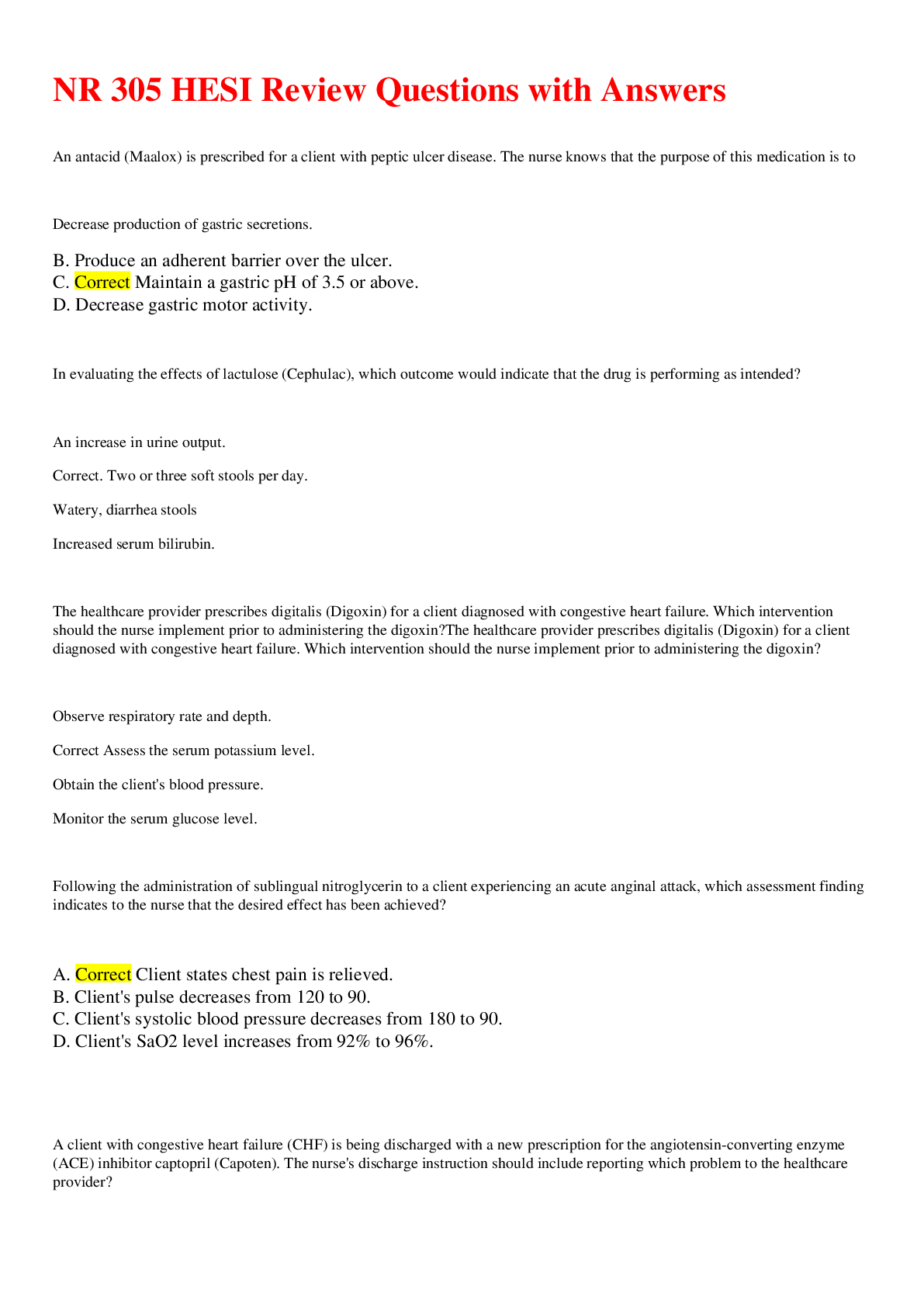
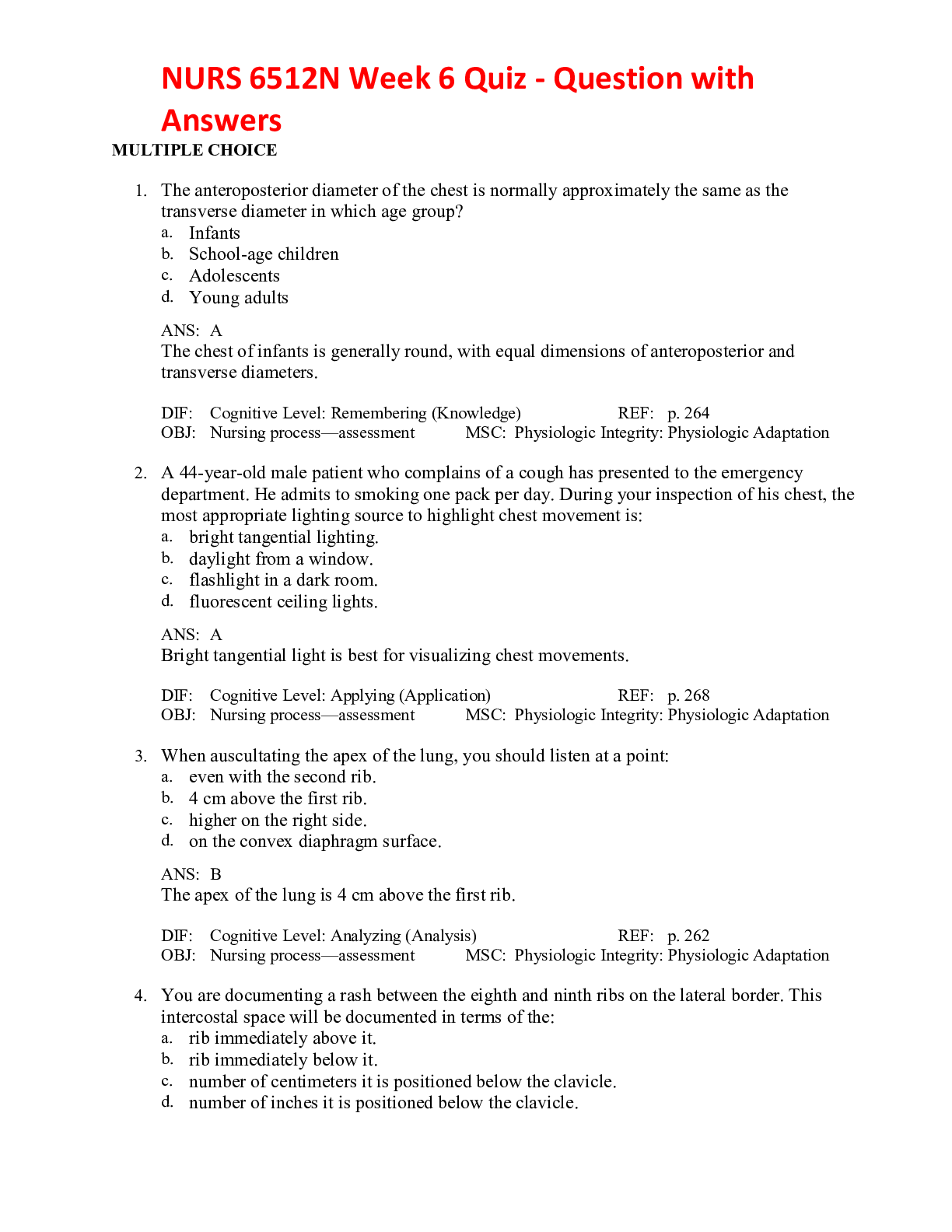
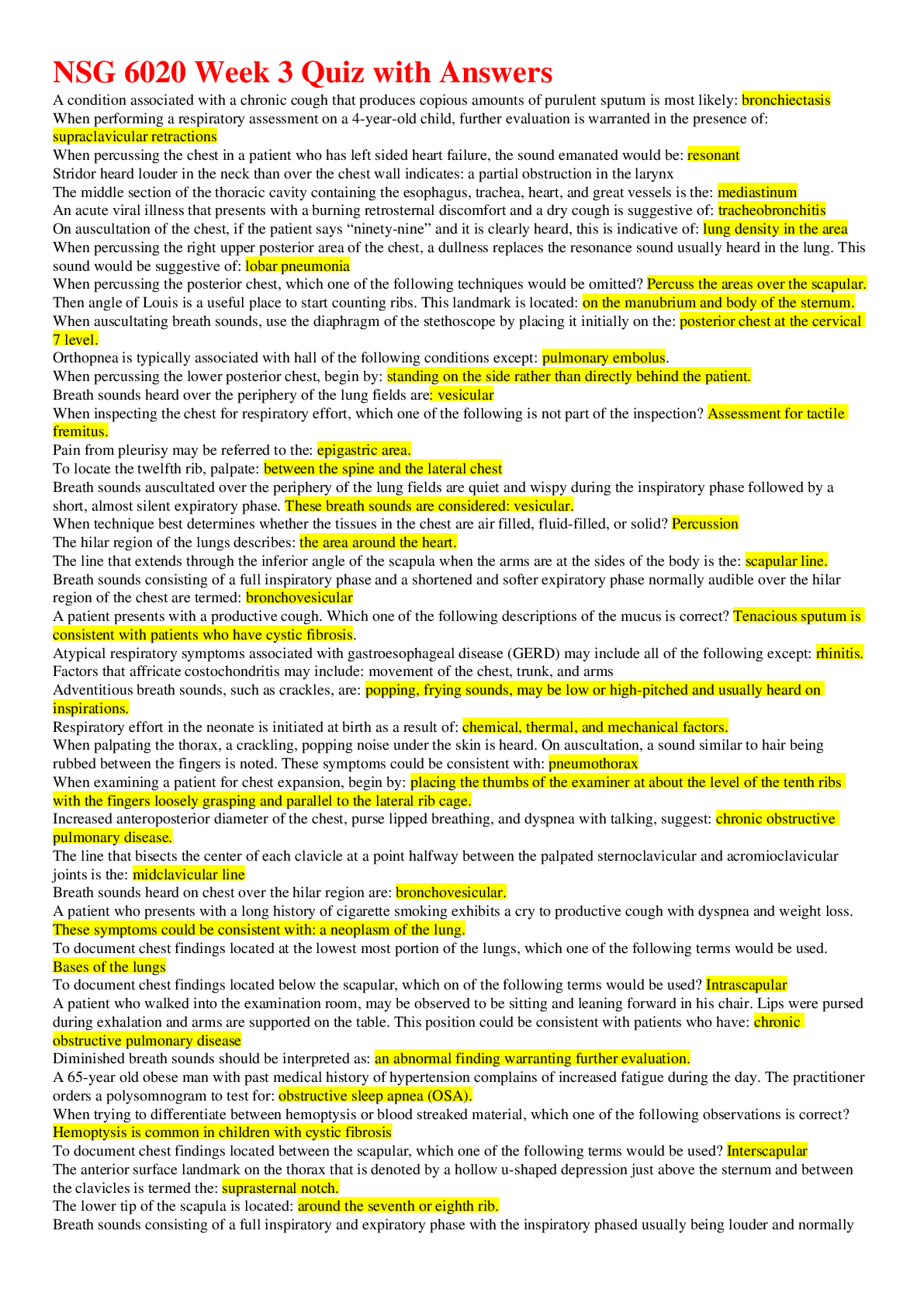
.png)
